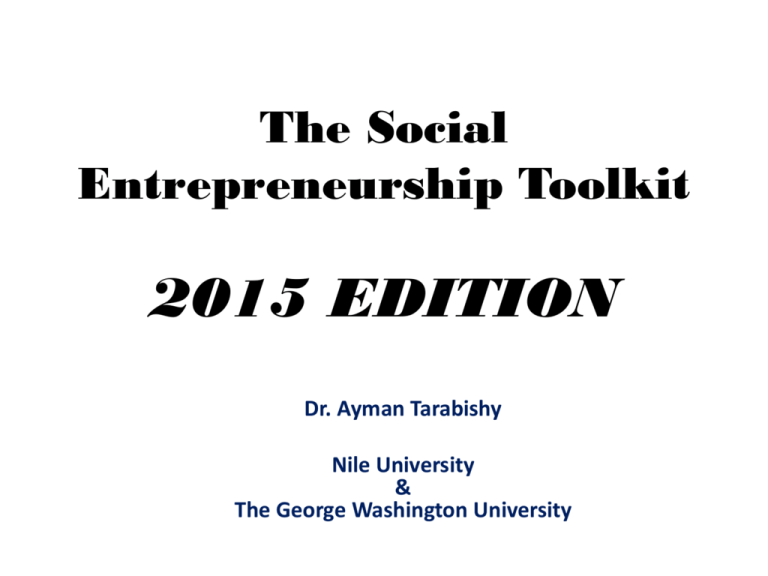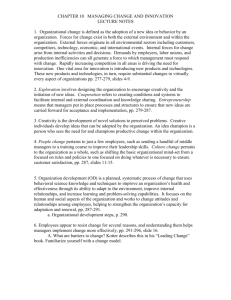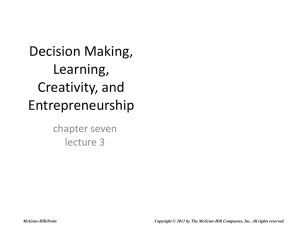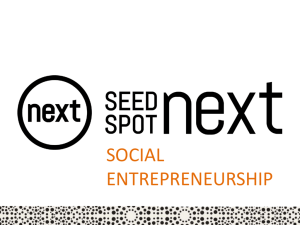Session 8
advertisement

The Social Entrepreneurship Toolkit 2015 EDITION Dr. Ayman Tarabishy Nile University & The George Washington University Social Entrepreneurship Toolkit – 2015 Edition • The SE2015 Toolkit will be organized as following: – The Person – The Idea – The Business Model – The Execution Part I. Why People Go Into Social Businesses • Social Opportunity – why do they go into business – – – – – – Self-Realization, e.g., fulfill a personal vision *** Financial Success, e.g., financial security * Recognition, e.g., respect from friends, etc. ** Roles, e.g., continue family tradition * Innovation, e.g., develop an idea *** Independence, e.g., flexibility in personal life * *** ** * Highly Likely Likely Not very likely Definition of Social Entrepreneurship • Addresses social problems or needs that are unmet by private markets or governments • Social entrepreneurship is motivated primarily by social benefit • Social entrepreneurship generally works with – not against – market forces 4 The only big difference between commercial and social entrepreneurship: Denomination of the returns Social and commercial entrepreneurship have most of the same characteristics 5 Social Innovation • Social innovation is, “a novel solution to a social problem that is more effective, efficient, sustainable, or just than existing solutions and for which the value created accrues primarily to society as a whole rather than private individuals” (Phills, et. al, 2008). Part II. What’s your view in Creativity and Innovation? Innovation Creativity Innovation Innovation Creativity Creativity Innovation Creativity Different but overlapping concepts Innovation: Introducing successfully a change in an existing system Innovation Creativity Creativity: conceive and express new ideas Creative innovation However, it’s when creativity and innovation overlap that things get interesting! Creative Innovation defined reativity xecution Creative innovation is actionable: finding a solution (being creative) + implementing the solution (execute) Govindarajan (2010), http://blogs.hbr.org/2010/08/innovation-is-not-creativity/ PART III What’s a Business Model? • Three key questions to answer – identify all key assumptions for each: 1) Value Proposition [what customer values] 2) Value Delivery [how to make it happen] 3) Value Capture [how to get paid] (shall we get started??) CONSTRUCTION OF THE SOCIAL INNOVATION INDEX MARKET ECONOMY DIMENSION CIVIC ECONOMY DIMENSION Social innovation tends to be located at the points of contact between the two dimensions examined that group together all the indicators and are more concentrated in the territories. 11 www.businessmodelgeneration.com Possible Financing Sources Now You Are Serious • • • • • • • Your personal funds Mom and Dad; friends, family Venture capitalists Banks/Bankers Former owners/Take-backs Government Suppliers/Trade credit Conventional entrepreneur Social entrepreneur 1. Individualist vision 1. Community vision 2. Goods and services for market 2. Goods and services for community 3. Focus on the market 3. Focus on the solution of social issues 4. Traditional performance measures, like profit 4. Performance measures are social changes 9-18 Typology of Ventures VENTURE MISSION ECONOMIC SOCIAL ECONOMIC Traditional Social Ventures (Social Entrepreneurship) MARKET IMPACT SOCIAL Socially Responsible (corporate social responsibility) Enterprising Nonprofits = Hybrids Exist Neck, H.; Brush, C. and Allen, E. (2009). The landscape of social entrepreneurship, Business Horizons. Elsevier’s. 52. pp. 13-19. SE Toolkit 2015 INNOVATION MUST BE UNDERSTOOD INNOVATION MUST BE SHARED 20








